Book of the Month Archive
Georgiana Donavin, Scribit Mater. Marty and the Language Arts and Literature of Medieval England, Washington (DC): Catholic University of America, 2012.
The last decade has seen a veritable explosion in the appreciation of the many and varied meanings and experiences associated with the figure of the Virgin Mary. Alongside wide ranging analyses that trace change over centuries, and thus histroicise the figure of Mary, there are now a large array of studies which address particular language communities or specific genres or media. Such are the recent Lesley Twomey’s The Serpent and the Rose: The Immaculate Conception and Hispanic Poetry in the Late Medieval Period (Leiden, 2008) and Adrienne Williams Boyarin’s Miracles of the Virgin in Medieval England (Woodbridge, 2010).
Georgiana Donavin explores a particular aspect of Mary’s persona: her association with earning and teaching, with acquisition of the ‘language arts’. Scribit Mater cogently traces instances of Mary as inspiration for intellectual work and acquisition of the powers to create in language, with chapters on Mary as inspiration for the writers of her vernacular Lives; on the poetry – both Anglo-Latin and Middle English – created in her honour; on Mary as guide to the processes of mastering Latin – through the work of John of Garland and Chaucer’s Prioress’ Tale; and on the religious imagination she inspired even among the unlearned Margery Kempe.
The writing mother of the title inspired writing, taught her son to read, and supervised the studies of men. Yet such learning always came at a cost of separation from the vernacular, of exclusion, of physical pain. it remains for historians to build upon studies such as Donavin’s in exploring further the social meanings and consequences of the presence of the reading and teaching mother of God, alongside other equally powerful representations of her, and of other women and mothers in the later Middle Ages.
Professor Miri Rubin
(Queen Mary, University of London)
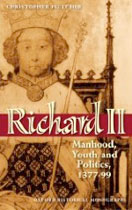
Richard II: Manhood, Youth, and Politics 1377-1399
Oxford University Press, September 2008
by Christopher Fletcher
Drapers' Research Fellow, Pembroke College, Cambridge
Today we like to think that youth and maturity are as much about mindset as they are attributes of our chronological age: modern culture celebrates the positive qualities of youth and encourages us to avoid the curse of middle age by staying youthful in body and mind. In the Middle Ages - and not just among the middle-aged – the libertine behaviour of the young (or, rather, of young men) was often interpreted rather more severely, and in particular was taken to denote their unsuitability for positions of responsibility and power. As a consequence, the accession to the throne of a young king was seen as deeply challenging to political stability. Christopher Fletcher has, for the first time, undertaken a sustained analysis of the theme of youth as it worked itself out in the politics of Richard II’s reign. He shows that Richard’s early accession, at the age of ten, and the problems of establishing his personal rule during the period up to and beyond his twenty-first birthday, allowed contemporaries to extend artificially the chronological range of the king’s youth and to use the wilfulness and ‘luxury’ associated with youthful living as a criticism of his style of government throughout the reign. When Richard was forcibly removed from the throne at the age of thirty-three in 1399, his own youthfulness was compared negatively with the self-conscious maturity of his usurper, Henry IV, in spite of the fact that the two men were almost exactly the same age. The malleability of youth, as Fletcher shows in this thought-provoking study, was thus a powerful rhetorical device in the debate on who was, and was not, fit to rule in late medieval England.
- Mark Ormrod
University of York
(Originally posted September 2008)
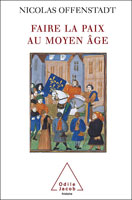
Faire la Paix au Moyen Âge: Discours et gestes de paix pendant la guerre de Cent Ans
Paris: Odile Jacob, 2007
by Nicolas Offenstadt
From Edward III’s defiance of Philip VI in 1337 until the noble rebellions of the 1460s, declarations of peace must often have seemed more prevalent in late medieval France than the enjoyment of peace itself. Peace with England at Brétigny in 1360 did not bring an end to violence, but its continuation in the activities of mercenary routiers. Even the long truce sealed at Ardres in 1396 served only to set the scene for the civil wars between Armagnac and Burgundian factions, marked throughout by repeated acts of peace which served only to rehearse the failure of past agreements. No wonder, then, as Nicholas Offenstadt observes at the beginning of this fascinating study, that French historians of this period have been more interested in war than in peace. The people were right to know that when the princes talked of peace, war could not be far behind.
Yet, as this book demonstrates beyond possible contradiction, just because recurrent rites of peace did not achieve their professed aims does not mean that their study is empty of interest. Instead, a different approach is necessary, an approach informed as much by the methods of the anthropologist as by those of the political or diplomatic historian. For let me be clear: what is remarkable about this book is the way it exemplifies not only the author’s mastery of an enormous wealth of documentary evidence, published and unpublished, ranging over 150 years, but also his active engagement with the work of social scientists. No slavish follower of theory for theory’s sake, Offenstadt makes use of the work of researchers working in parallel disciplines, sometimes confirming their findings, sometimes reaching new conclusions. Thus this four-part study moves from the interchange between ideals of heavenly and earthly peace; to the roles of different actors (real and imaginary) in the process of peace negotiation; to the rites of peace themselves; and finally to the complex relationship between the peace of the princes and the peace of the kingdom. Along the way, it is not just peace that is illuminated but a whole series of questions, questions of interest not only to political but also to social and cultural historians. There is matter here for the historian of memory, in discussion of the processes of forgetting and enforced silence which peace required; for the historian of ritual, of emotion and of gesture, as the author deals skilfully with the need to avoid denaturing rites of peace by extracting the emotional experiences of their actors; and for historians of communication and of the state, through an approach which remains aware that the impact and significance of politics was not restricted to princes, and that ideas can never be separated from their social enactment. Peace in late medieval France, as this book makes clear, was not an on-or-off state but a complex and wide-ranging network of social processes. Its study is rich with lessons for all manner of historians and social scientists.
- Christoher Fletcher
Pembroke College, Cambridge
(Originally posted January 2009)
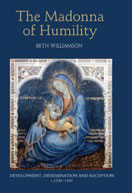
The Madonna of Humility. Development, Dissemination & Reception, c.1340-1400
Woodbridge: Boydell Press, 2009
by Beth Williamson
Madonna of Humility is an image of the Virgin Mary and Christ Child that developed in central Italy and Avignon by the middle of the fourteenth century; the earliest dated example is of c.1346. The Madonna of Humility depicts Mary seated on the ground, often on a cushion or within a garden, sometimes suckling her son. Beth Williamson works with historical rigour to explore three important aspects of this image: its origins, its dissemination, and its uses. These are deeply historical questions to which she offers convincing answers. She suggestively likens the spread of the image – to Charles IV’s Prague and then Bohemia, to Siena – to a process of translation. Moreover, though the Madonna of Humility is best known from panel paintings, the origins of the theme is probably to be found in manuscript illumination of Hours of the Virgin in earlier books of prayer; in the image of the Woman of the Apocalypse and in scenes of the Annunciation. All this leads Williamson to suggest that the distinctive image known beast from Italian panel paintings, may have its origins in northern books for private prayer. Equally interesting are the cases in which Williamson examines the ‘uses’ of the image, by individuals, families and communities. Here is art historical scholarship which is indispensible to the historian. Madonna of Humility is an essay on late medieval European culture seen through the dialectic of shared themes and local articulation, public art and private devotion.
- Miri Rubin
Queen Mary, University of London
(Originally posted June 2009)
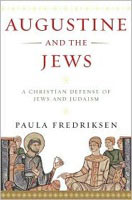
Augustine and the Jews. A Christian Defence of Jews and Judaism
Doubleday: New York, 2008
by Paula Fredriksen
Amidst the prevailing anti-Jewish sentiment that emerged during the first three centuries of Christianity, Augustine of Hippo (354-430) is conspicuous in his arguments on behalf of the Jews. Whereas anti-Judaism became a theological ideology central to Christian identity in the third and fourth centuries, a period of astounding creativity, between 396 and 430 Augustine developed a new vision of Jews and Judaism, one significantly different not only from that of his Manichean opponents, but also from his that of Christian thinkers.
In Augustine and the Jews, Paula Fredriksen explores two different but closely related topics. First, she investigates the development of a virulent Christian anti-Judaism in the first centuries by reaching back to the creation of strong bonds between ethnicity and religious loyalty in the Hellenistic period. Secondly, she carefully delineates the influences and developments that brought Augustine to his stance in defence of the Jews. His influence on later thinkers and policy makers was enormous, like on Bernard of Clairvaux (1090-1153), who banned crusaders from harming the Jews on their way to the Holy Land. Augustine and the Jews is a remarkable contribution to our knowledge of Jewish-Christian relations in Late Antiquity and the Middle Ages, and a singular contribution to the understanding of Augustine himself.
- Yitzhak Hen
Ben-Gurion University
(Originally posted July 2009)

The N-Town Play: Drama and Liturgy in Medieval East Anglia
Cambridge: D. S. Brewer, 2009
by Penny Granger
The manuscript preserving the N-Town plays is an anthology of plays (an original cycle of plays, a Mary play, and two Passion plays), and in The N-Town Play Penny Granger identifies the relationship between the various ‘pageants’. She argues that the N-Town plays are unique in the corpus of medieval drama not only because they incorporate so much liturgical matter but also because the authors integrated it into the dramatic action. A good example is the Visitation scene where Mary’s Latin Magnificat alternates verse by verse with Elizabeth’s English translation. Granger compares selected scenes with counterparts in plays from York, Chester, Towneley, the Middle Dutch Bliscapen cycle, and Lydgate’s verse Life of Our Lady, noting that in these works the liturgical texts are typically set-pieces and non-dramatic in contrast to N-Town. By widening her range to include the Digby Mary Magdalen and Candlemass, as well as the Croxton Play of the Sacrament, she is able to extend her thesis to East Anglian drama in general. To account for this penchant, she turns in her final chapter to address the issues of literary and social milieu, performance theory, scribal practice, and audience. The act of anthologising a collection of play texts, she concludes, created a work suitable for devotional reading. The N-Town Play is a significant addition to the literature on medieval drama as well as to the broader field of East Anglian studies. Here is a book which will be of interest to scholars of drama as well as for students encountering medieval drama for the first time.
- Ann Eljenholm Nichols
Cambridge
(Originally posted August 2009)
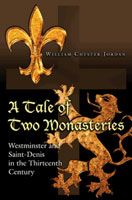
A Tale of Two Monasteries: Westminster and Saint-Denis in the thirteenth Century
Princeton and Oxford: Princeton University Press, 2009
by William Chester Jordan
William Chester Jordan’s latest book tracks the lives of abbots Richard de Ware of Westminster Abbey and Mathieu de Vendôme of Saint-Denis, two men whose prominent ecclesiastical positions in these important royal abbeys made them prime movers in some of the most delicate but decisive issues of the second half of the thirteenth century. In following the lives of the abbots, readers become acquainted with the major political events of the day: the Baron’s Revolt in England, the treaties between France and England, royal succession, papal politics in Italy, and crusade. Readers also are apprised of the matters specific to each of the abbeys in the thirteenth century: their modes of governance and administration, the new building campaigns, and their forms of self-preservation and legitimisation.
Saint-Denis and Westminster were not in direct competition with each other, they shared the goal of becoming most important to their royal associates and patrons. Jordan details how each abbot had to negotiate loyalty to the king and allegiance to his abbey. The ultimate success of the abbots’ strategies is revealed in each man’s political elevation, which worked to the benefit of his institution: Richard de Ware, who was sent on endless diplomatic expeditions for Henry III to Westminster’s initial detriment, was at the end of his life placed by Edward I in the position of Treasurer where he could redeem the abbey’s glory. Mathieu de Vendôme, a talented but quiet diplomat, was called to serve as regent of France not once but twice during this period when the status of Saint-Denis as a medieval lieu de mémoire for the French monarchy was being definitively established.
The comparative approach illuminates both numerous similarities and significant differences between the abbots and their respective abbeys and their place within the broader history of Europe. With exemplary navigation of the primary sources, Jordan deftly interweaves the individual biographies of these two men into ecclesiastical and royal history, revealing the importance of the specific in relation to the broad issues that defined the thirteenth century.
- Meredith Cohen
Institute for Medieval Studies, University of Leeds
(Originally posted September 2009)

The Medieval Prison: A Social History
by Guy Geltner
(Princeton: Princeton University Press, 2008)
Guy Geltner’s The Medieval Prison: A Social History (Princeton: Princeton University Press, 2008) argues that it is a modern misconception to envision medieval prisons as hell-holes set apart and isolated from society. Instead, based on archival material primarily drawn from Florence, Venice and Bologna, Geltner suggests that medieval prisons in northern and central Italy, if not altogether agreeable places, were at least tolerable sites of incarceration primarily because unlike modern prisons situated on the margins of society, purposefully isolating inmates from social interaction, medieval prisons stood at the heart of the city’s urban fabric, allowing for continuous contact with family, friends, business associates, and the outside world. They were penal institutions meant to control and warehouse but not to reform or eliminate their inmates. Emerging in the late thirteenth century, the very existence of these single-use institutions challenges the literature on prison history, which seeks to identify the modern autonomous penal institutions as linked to the rise of the modern state. Examination of prison account books has allowed Geltner to reconstruct something of the medieval institution: how Italian prisons were staffed, the layout of the wards, what crimes merited imprisonment (debt tops the list), how much it cost to incarcerate a prisoner (the inmate not the state was liable), the average length of incarceration (six to twenty-four months), among other interesting topics. Geltner’s study succeeds in embedding the medieval prison firmly in its urban matrix. It also raises the question: how might these Italian examples help us understand other penal systems in Western Europe and beyond.
- Katherine L. Jansen
The Catholic University of America
(Originally posted October 2009)
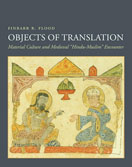
Objects of Translation. Material Culture and Medieval “Hindu-Muslim” Encounter
by Finbarr B. Flood
(Princeton: Princeton University Press, 2009).
One of the most ambitious books published in the field of Islamic studies in recent years, this work challenges the very notion of “Islam” as a meaningful marker of cultural identity in the medieval context. The focus of the work is the material culture of Muslim and Hindu elites in the frontier zones during the early medieval period, from the Muslim conquests in Sind in the eighth century up to the foundation of the Sultanate of Delhi five centuries later. It discusses coins, artifacts and buildings produced by and for these Muslim and Hindu elites, and shows - often with brilliant insight - how these representations of power always interacted with symbols of power from across the border. The author argues that the contact between the Turkish-speaking Muslim elites and the Indian ones did not produce a hybrid identity, or caused one culture to borrow from another. Rather, identity itself was produced through dynamic contact with the other, and identity was refashioned and reinvented continuously according to shifts in the balance of power.
The most striking and memorable material evidence for these claims comes from Islamic coins with Sanskrit inscriptions and Hindu iconography, and from the extensive and systematic use of spolia in the buildings erected by the Muslim conquerors of India. This pattern is particularly pervasive in the monuments left by the Ghurids, the Afghan dynasty who accomplished the conquest of northern India in the late 12th century. For the author, the Ghurid use and transformation of indigenous Indian symbols in their architecture is a process of translation by which the vocabulary of both Muslim and Hindu languages of power shifted continuously. The linguistic metaphor, is over-drawn and sometimes obscured by the theoretical tone, but the insight offered are genuinely and admirably thought-provoking. They oblige the reader to question the hierarchy of core and periphery in which we usually understand, and through which we teach, medieval Islamic civilization, and inspire us - at least try – and imagine Islamic identity as intrinsically relational.
- Yossi Rapoport
Queen Mary University of London
(Originally posted November 2009)
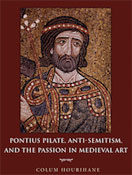
Pontius Pilate, Anti-Semitism, and the Passion in Medieval Art
by Colum Hourihane
(Princeton and Oxford: Princeton University Press 2009)
Pontius Pilate, one of the main characters in Christ’s Passion, at the heart of the Christian story, features extensively in Christian culture from Late Antiquity onwards. Hourihane's elegant and richly presented volume provides a visual and textual history of this complex figure. It traces Pilate's changing depiction from a just Roman governor in early Christian sources to a wicked Jew in the Middle Ages, rand on to the return to the image of a just ruler in the fifteenth century. Although in Jewish sources Pilate in known as an oppressor of the Jews, and the Gospels stress his efforts to prevent the death of Jesus, in Christian representations he was none the less often depicted as a Jew. Medieval artists often dressed him in what came to be seen as a ‘Jewish hat’, thus suggesting his complicity in the Crucifixion. Pilate thus came to mirror emergent trends in medieval anti-Judaism. This book will interest and inform historians, literary scholars, and art historians alike.
- Ora Limor
Open University of Israel
(Originally posted April 2010)
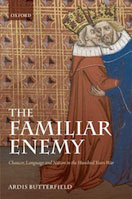
The Familiar Enemy: Chaucer, Language, and Nation in the Hundred Years War
by Ardis Butterfield
(Oxford: Oxford University Press, 2010).
This will be recognized as one of the most important books in Middle English and Chaucer Studies of the last thirty years. It will also prove influential in related fields, such as History and French; and it offers illuminating long perspectives on contemporary debates on where and when nationhood begins and ends, and on how linguistic practices mesh with territorial and political structures. Through sedulous examination of French/ English interchange, at a crucial period of “national” emergence, it shows that no one group, however authoritative, can possess a language; nor can a language, however prestigious, be saved from creative contamination. Those who speak with strange accents, then as now, change the normalizing language of nationhood even as it attempts to trap or misrecognize them through parody and (mostly comic) imitation. This is a deeply scholarly and a timely book.
Butterfield’s project, and its modus agendi, is highly distinctive. Firstly, she deals chiefly with secular texts; secondly, her analysis works both ways: that is, she is interested both in the French of England and in the English in France (as registered by little-studied French texts). Her contact zone is actually neither France nor England, but an intermediate space of complex linguistic exchange; thirdly, Butterfield works chiefly through detailed analyses of literary texts. For Butterfield literary texts do not simply illustrate processes of nation building that must first be learned or inferred from historical and economic analyses; they actually participate—in every interlinguistic encounter—in fabricating “national character.”
Butterfield has redefined what medieval Englishness might mean in wholly provocative and original ways; the profession has hardly had time to catch its breath in order to assess this pathbreaking work. In nuce, Butterfield has argued that medieval Englishness is, in its most significant cultural forms, Frenchness: that is, the language of France dominated élite textual production in England in ways that Victorian-derived English historiography has been slow to recognize. The Familiar Enemy dissolves traditional boundaries in demonstrating how French cultural texts served a cross-Channel populace corresponding to no particular nation; it leads us, in short, to question the very meaning and viability of the term nation for the medieval English period as a unifying cultural term. The Familiar Enemy is thus a brilliant and timely book.
David Wallace, University of Pennsylvania
(Originally posted May 2010)
